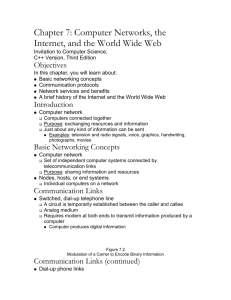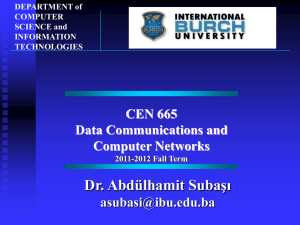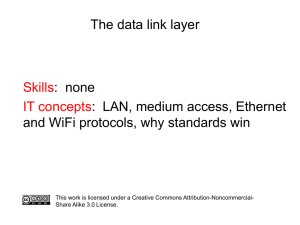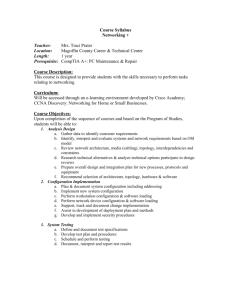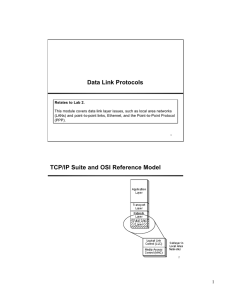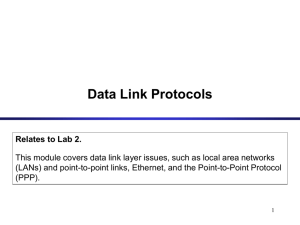Question Bank Unit 1
advertisement
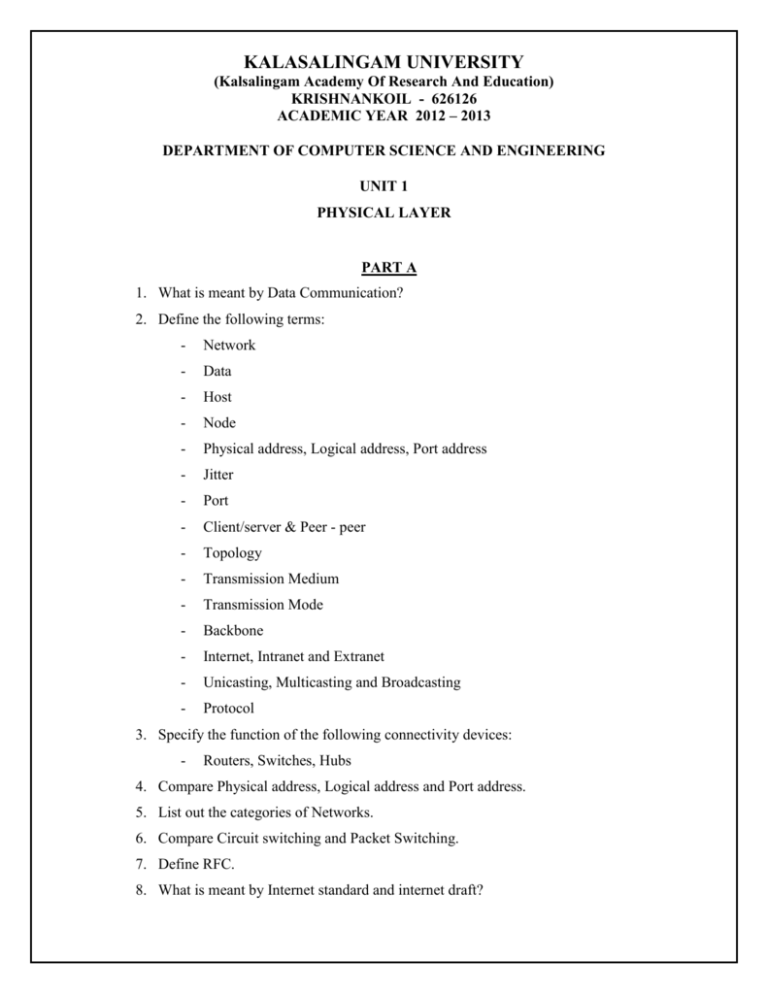
KALASALINGAM UNIVERSITY (Kalsalingam Academy Of Research And Education) KRISHNANKOIL - 626126 ACADEMIC YEAR 2012 – 2013 DEPARTMENT OF COMPUTER SCIENCE AND ENGINEERING UNIT 1 PHYSICAL LAYER PART A 1. What is meant by Data Communication? 2. Define the following terms: - Network - Data - Host - Node - Physical address, Logical address, Port address - Jitter - Port - Client/server & Peer - peer - Topology - Transmission Medium - Transmission Mode - Backbone - Internet, Intranet and Extranet - Unicasting, Multicasting and Broadcasting - Protocol 3. Specify the function of the following connectivity devices: - Routers, Switches, Hubs 4. Compare Physical address, Logical address and Port address. 5. List out the categories of Networks. 6. Compare Circuit switching and Packet Switching. 7. Define RFC. 8. What is meant by Internet standard and internet draft? 9. List out the 6 maturity levels of RFC. 10. List out the 6 requirement levels of RFC. 11. Specify the need for protocol. 12. List out the two types of Line configuration. 13. Name the four basic network topologies. 14. List out the advantages of Multipoint connection over point-point connection? 15. List the 5 components of Data communication. 16. Name the 3 modes of communication carried between two devices. 17. Define protocol layering. 18. Mention the two principles of protocol layering. 19. Write short notes on TCP/IP Protocol suite. 20. List out the layers in TCP/IP Protocol suite. 21. Define the terms: Datagram, Frame. 22. State the functions of each layer present in TCP/IP Protocol suite: (Physical Layer, Data Link layer, Network layer, Transport layer, Application layer). 23. Write short notes on addressing in TCP/IP Protocol Suite. 24. Abbreviate the terms: TCP, UDP,SCTP. 25. Name the protocols present in each layer of TCP/IP model. 26. Specify the reasons why OSI model fails to succeed. 27. Define the terms: - Analog data, Analog signal - Digital data. Digital signal - Wavelength and Bandwidth 28. What is the relationship between period and frequency? 29. What is meant by Bit rate and Bit length& Sampling rate? 30. List the categories of Transmission impairments. 31. Name the factors in which the data rate depends. 32. List the two formulas developed to calculate the data rate and define it. 33. Define the characteristics that measure the network performance. 34. List out the categories of Data transmission. 35. Differentiate Synchronous, Asynchronous and Isochronous transmission. 36. List out the categories of Analog to analog conversion. 37. Define Multiplexing and De multiplexing. 38. Compare time division and Wavelength division multiplexing. 39. List out the schemes of TDM. 40. Write the functions of Statistical time division multiplexing. 41. Define Pulse stuffing or Bit padding or Bit stuffing. 42. What is meant by frame synchronizing? 43. What is meant by framing bits? 44. What is meant by spread spectrum? State its principles. 45. Compare FHSS and DSSS. 46. Define Barker Sequence. 47. List out the classes of Transmission medium. 48. Compare STP and UTP. 49. List out the propagation modes of Optical fiber cable. 50. What is the purpose of Cladding in Optical fiber? 51. What are the several ways of propagation in unguided media? 52. List out some characteristics of Microwaves. 53. What is the position of Transmission media in Internet model? 54. Compare unidirectional and Omni directional antennas. 55. Define the two types of antenna used for microwave communication. 56. List out the categories of Wireless transmission. 57. List out the applications of Wireless transmission categories. 58. Compare infrared and Microwave transmission. 59. Compare serial and parallel transmission modes. 60. Compare Multimode step index fiber and Multimode graded index fiber. 61. List out the advantages of packet switching over circuit switching. PART B 1. Write short notes on components of Data Communication(4) 2. Write short notes on modes of data flow between two devices(6) 3. Explain in detail about different types of network topologies(16) 4. Categories of Networks – Explain with schematic representation (8) 5. Compare Packet Switching and Circuit Switching (6) 6. Discuss in detail about the various functions of TCP/IP Protocol suite with necessary diagrams.(16) 7. Compare OSI and TCP/IP.(8) 8. Explain the Schematic representation that depicts the operation at physical layer(8/6) 9. Describe the approaches involved in the transmission of digital signals(8) 10. Explain the causes of transmission impairments.(8) 11. Explain the techniques involved in Digital to digital conversion with necessary representations(16) 12. Explain the techniques involved in Analog to digital conversion with necessary representations(16) 13. Explain the techniques involved in digital to Analog conversion with necessary representations(16) 14. Explain the techniques involved in Analog to Analog conversion with necessary representations(8) 15. Data Transmission modes – Discuss its functions(8) 16. Briefly explain the categories of Multiplexing with functions, applications & diagrammatic representation. 17. Describe the approaches involved in the spread spectrum(8) UNIT II DATA LINK LAYER PART A 1. Write short notes on Services provided by Data link layer. 2. List out the categories of links. 3. Specify the address defined by link-layer protocol. 4. Define ARP. 5. Specify the need for caching in ARP. 6. List out the types of errors. 7. Compare Error Detection and Correction. 8. Specify the categories of Coding scheme. 9. State the advantages of cyclic codes. 10. Define Code words and Data words. 11. How can error be detected by using Block coding? 12. What is the definition of Linear Block code? 13. List out the operations of Data Link Control. 14. Define Byte Stuffing and Bit Stuffing. 15. Define Piggybacking and its benefits. 16. Compare and Contrast Bit Stuffing & Byte Stuffing. 17. Compare and Contrast Byte oriented & Bit oriented protocols. 18. Compare and Contrast Flow control and Error control. 19. Explain why there is no need of CRC in the Simple protocol. 20. Abbreviate: LCP, PAP, CHAP, and IPCP. 21. What are the transfer modes used in HDLC? 22. Write the functions of CSMA/CD and CSMA/CA. 23. Abbreviate: CSMA/CD, CSMA/CA. 24. What is the purpose of NAV in CSMA/CA? 25. Name the persistence methods in CSMA. 26. Compare ALOHA and CSMA/CD. 27. Abbreviate: DIFS, SIFS. 28. Define Handshaking. 29. State the solution to hidden station problem. 30. Write short notes on token passing mechanism. 31. State the use of Walsh table in CDMA. 32. Specify why collision is an issue in random access protocols but not in controlled access protocols. 33. Specify why collision is an issue in random access protocols but not in Channelization protocols. 34. Draw Ethernet frame format. 35. What is meant by Auto negotiation? 36. List out the goals of Gigabit Ethernet Design. 37. List out some of the characteristics of Standard Ethernet. 38. Define Carrier Extension and Frame Bursting. 39. Compare the data rates for Standard Ethernet, Fast Ethernet, Gigabit Ethernet, and 10 Gigabit Ethernet. 40. What is the relationship between Switch and Bridge? 41. Compare Unicast, Multicast and Broadcast address. 42. What is the difference between forwarding port and blocking port? 43. How a VLAN does reduce Network Traffic? 44. State the advantages of using VLAN. PART B 1. Discuss in detail about forward error correction (8). 2. Write short notes on the algorithm to calculate the traditional checksum (8). 3. Discuss in detail about the coding schemes (16) 4. List out the DLC Services and explain its functions (16) 5. Explain the operations of protocols which are responsible for flow control and Error Control (16) 6. Bit oriented protocol used for point to point and Multipoint links - illustrate with its transfer modes and frame types (16) 7. Briefly write about the Services, Transition phases and Authentication protocol for PPP (16) 8. Write short notes on PPP frame format (6) 9. Write about the functions of protocols which are responsible for establishing, maintaining and configuring and terminating links in PPP(16). 10. Discuss in detail about the mechanisms involved in random access protocols (16). 11. Write short notes about the 3 controlled access mechanisms (8). 12. Channelization Protocols – Explain with its functions with representations and examples (16). 13. Write about the addressing mechanism in standard Ethernet and Compare Unicast, Broadcast and Multicast transmission (10) 14. Discuss in detail about the implementation mechanisms of standard Ethernet and also mention the changes that occurred to the 10-Mbps Standard Ethernet (16). 15. Describe in detail about the functions of Gigabit Ethernet standard, 10 Gigabit Ethernet and Fast Ethernet (16). 16. Explain the mechanisms involved in Link Layer Switches (16). 17. Compare the functions, advantages and Disadvantages of connectivity devices (10). 18. Compare the functions of different Backbone Networks(8).

